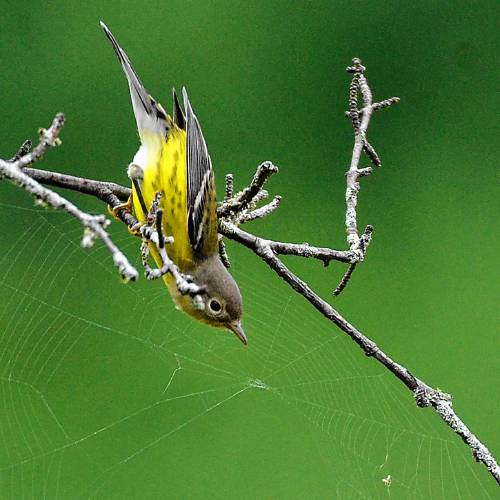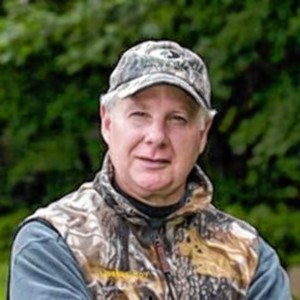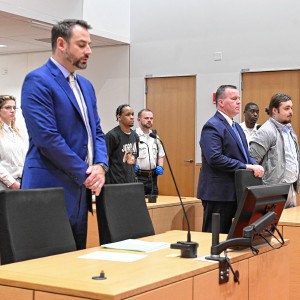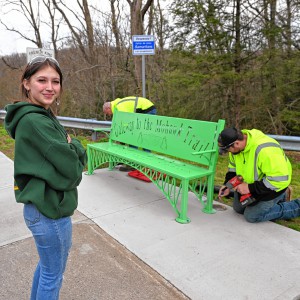Speaking of nature: I want that fly — Observations of a hungry magnolia warbler

In the bottom right corner of this photo you can see a small white spot. This is actually an insect, and the magnolia warbler desperately wants it. PHOTO BY BILL DANIELSON
| Published: 09-17-2023 9:31 AM |
The first week of September was appalling. The highest combination of head and humidity that we had experienced all summer all presented in a heat wave that lasted for four days. Then, even though the temperatures moderated somewhat, the humidity lingered and it started raining again. The summer started with soggy, rainy weather and then ended with the same. Symmetry enthusiasts might have enjoyed it, but I was not among them.
The first week of September was also week full of traditional classes at school and by the end of the week I was desperately craving some time outside. The week had seen temperatures in the 90s, so there wasn’t a great deal of lounging out on the deck and communing with nature. The weekend was cloudy, humid and rainy, but it was also warm enough to make sitting in the Thinking Chair a very pleasant endeavor. Armed with a travel mug full of coffee and my trusty old camera, I logged a total of four hours of observations; two hours each on Saturday and Sunday.
The difference between my Labor Day weekend observations the week prior and the two days that made up the following weekend were astounding. We are in the middle of migration and the movement of the birds is now being keenly felt. Earlier in the season, migrants from Canada were added to the numbers of “regulars” in the meadow. Last weekend, however, I really noticed the fact that “my” birds — the birds that had spend months getting to know me — had gone. The activity level around me had suddenly dropped to almost nothing.
Saturday was particularly quiet as the result of some expansive storms that had moved through the area, but on Sunday there was a surge of movement through Maine and down into southern New England. I was very optimistic when I saw the radar map on BirdCast (run by UMass Amherst and Cornell University) and even though the morning started out slowly, I was convinced that I was going to see something. As it turns out, I was not wrong.
I caught sight of a movement in the low alders and dogwoods to my left and saw the telltale hints of yellow that indicated a warbler of some sort. The bird was in a state of near constant movement as it frantically searched for food and I mumbled more than one curse as it continued to elude me. As is the way with warblers, this one would sit still long enough for me to zero in on it, but not long enough for me to focus my camera. It is absolutely maddening.
Then I caught a remarkable break. The warbler emerged from the underbrush and flew out into the meadow where it landed in a buckthorn tree that was growing alone in the tall grasses. Because of its position, this particular tree is not very “happy.” It gets too wet, which means it is somewhat unwell. Believe it or not, this is great for me because the birds that land in the branches of this tree are usually very easy to see. As a result, it took me only a moment to see that the bird I was watching was a female magnolia warbler (Setophaga magnolia).
First identified in 1810 by the famous ornithologist Alexander Wilson, the magnolia warbler is a breeding bird of the arboreal forests of extreme northern New England and a huge swathe of southern Canada. In a curious accident of fate, Wilson “collected” the first specimen in Mississippi, which is a nice way of saying that he shot a bird with a shotgun. The bird happened to be sitting in a magnolia tree at the time, so Wilson used the name of the tree as the species name in the bird’s scientific name. Over time, the bird simply became known as the magnolia warbler.
The bird that I saw in my meadow 213 years later was a female. Males have striking black-and-yellow feathers whereas the females are a more subdued gray-and-yellow. The white eye ring on an otherwise gray head is a good field mark. The light streaking on the yellow flanks is another great identifier, as is the white region of the ”undertail coverts.” This photo shows them all! But the reason I like this photo is not because of the field markings on the birds. Instead, I like this photo because it shows how energetically motivated to find food she is.
Article continues after...
Yesterday's Most Read Articles
 Greenfield homicide victim to be memorialized in Pittsfield
Greenfield homicide victim to be memorialized in Pittsfield
 Former Greenfield man granted new trial after 1995 murder conviction, walks free
Former Greenfield man granted new trial after 1995 murder conviction, walks free
 On The Ridge with Joe Judd: What time should you turkey hunt?
On The Ridge with Joe Judd: What time should you turkey hunt?
 Judge sets bail for Millers Falls assault suspects
Judge sets bail for Millers Falls assault suspects
 Franklin Tech student welds artistic bench for French King Bridge
Franklin Tech student welds artistic bench for French King Bridge
 As I See It: Between Israel and Palestine: Which side should we be on, and why?
As I See It: Between Israel and Palestine: Which side should we be on, and why?
Behind this bird you can see a spider web and in the bottom right corner you can see a light-colored dot that is in fact an insect that is caught in the web. This female magnolia warbler is acrobatically leaning forward in an effort to steal the fly from the spider. Holes in the web show where she had successfully pilfered a couple other morsels and you can hardly blame her. After a marathon of flight all through the night she must have been ravenously hungry. And she has more than 1,000 miles to go before she reaches her winter destination in the Caribbean Islands and Central America.
The birds are moving and you may have noticed that all of the familiar faces in your yard have disappeared. This is going to continue for a few more weeks and then all of the summer breeders will be gone. By the end of October the “winter birds” will be here and they will once again be looking for food at our feeders. As soon as the bears turn in for the winter, we can ring the dinner bell for the birds and we will see all of the familiar faces once again; warblers only visible in our dreams until next spring.
Bill Danielson has been a professional writer and nature photographer for 26 years. He has worked for the National Park Service, the U.S. Forest Service, the Nature Conservancy and the Massachusetts State Parks and he currently teaches high school biology and physics. For more in formation visit his website at www.speakingofnature.com, or go to Speaking of Nature on Facebook.

 Speaking of Nature: Indulging in eye candy: Finally, after such a long wait, it’s beginning to look like spring is here
Speaking of Nature: Indulging in eye candy: Finally, after such a long wait, it’s beginning to look like spring is here Celebrating ‘Seasonings’: New book by veteran preacher and poet, Allen ‘Mick’ Comstock
Celebrating ‘Seasonings’: New book by veteran preacher and poet, Allen ‘Mick’ Comstock Faith Matters: How to still the muddy waters of overthinking: Clarity, peace and God can be found in the quiet spaces
Faith Matters: How to still the muddy waters of overthinking: Clarity, peace and God can be found in the quiet spaces A time for every purpose under heaven: Free sing-a-long Pete Seeger Fest returns to Ashfield, April 6
A time for every purpose under heaven: Free sing-a-long Pete Seeger Fest returns to Ashfield, April 6
